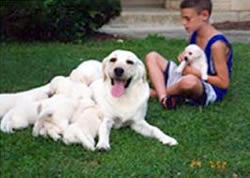 |
Sign Up For Our Newsletter!
 |
||
Veterinary Topics: ReproductionSee Also: Feeding
the Adult Labrador | Preventative
Medicine | Obstetrics
But........... if you have ever found yourself wondering six weeks later, "why isn't her belly getting any bigger?" I have a few things I'd like to share with you. You see, it was eight or nine years ago that Bainbridge, in cahoots with Mother Nature, pulled just the same trick on us. We had a young, healthy bitch, carefully observed her first days in estrous (heat), took a few vaginal cytology smears and somewhere around day 12 or so, took her to the stud dog. Over the next couple of days she was bred twice by natural service and was deemed ready to return back home when it appeared the stud dog was beginning to lose his aggressive interest in her. I might add that this is not an unusual sequence of events and in a majority of cases a pregnancy might result. However, as mentioned above, we counted the days on our calendar and marked the date her litter was due only to find that six weeks later Vicki was asking me the same question that I had been asking myself. "Why isn't Bainbridge's belly getting any bigger?". So, being her veterinarian, it was obviously my job to find an acceptable answer to that question. I had been rather well trained and experienced in the field of equine reproduction having worked with some of the finest Thoroughbred breeding stock in the world for many years. As a group, the Thoroughbred just might have as many breeding problems as can be imagined, so much of my time had been spent with finding answers to very similar questions regarding the equine species. But after formulating a plan, consulting with some of my colleagues and going through the check list of possible abnormalities that Bainbridge might have, I was left with news both good and bad. The good was that I had ruled out the common causes for subfertility and was able to give her a clean bill of health. Unfortunately, the bad news was that I was not able to determine the cause of her missed pregnancy. So as specialized as the field of veterinary medicine has become, I realized that Bainbridge was canine, not equine, and I had tried everything that I could. It was time to refer to someone who knew as much about reproduction in the dog as anyone, and I placed a call to my canine repro instructor from veterinary school. With her help we retraced all the steps I had taken, then formulated a simple, logical plan that would determine if Bainbridge might have a more serious problem that would require further invasive techniques to identfy, or if she was just playing "hard to get". We know there must be live, viable semen present in the female reproductive tract to fertilize the egg after it is ovulated, that is, released from the ovaries into the uterus. Certainly any problems that would cause an inadequacy in the quantity or quality of the semen would lead to fertility problems, but for the sake of our discussion, we'll assume a normal, healthy male is being used for breeding. In the equine species, we go to great lengths to predict the time of the mare's ovulation. Ideally, we want to breed her twelve to twenty four hours before ovulation for her best chance to conceive. The canine species, however, operates on a different reproductive clock. In the bitch, if you were only to breed her one time, one "cover" as we say, your best chance to produce the maximum number of pups would be to breed her forty-eight hours after ovulation. Therefore, it would make sense that if we could pinpoint when ovulation has occured, we would certainly want to be sure to have semen present in the uterus within twenty-four to forty-eight hours of that time. We are fortunate to have the ability to determine, with a very simple test, the time of ovulation in the bitch. That is accomplished by measuring the amount of the hormone progesterone in her bloodstream. Simply put, progesterone is secreted from the ovaries after the egg has been ovulated. Although it has many functions, it's major role may be the preservation of pregnancy. There are two basic types of progesterone tests that can be run. Qualitative and quantitative. The qualitative test simply determines the presence of the hormone in the blood in sufficient amounts indicative of an ovulation or an impending ovulation. The quantitive test does exactly as the name indicates. It measures the precise quantity of the circulating hormone present in the bloodstream at the time the sample was drawn. It allows you the opportunity to predict when ovulation has taken place and to accurately schedule your matings. In my hands, there is no substitute! If you have access to a reliable laboratory capable of running quantitative canine progesterone, use it! If you do not, you have three options: i) you can send me an email: whitelabs@bainbridgelabs.com, and
I will provide you with the name and address of the laboratory
that I send my samples to and have the utmost confidence
in. I have used this lab for both canine and equine testing
for many years. You should be able to send a sample via overnight
mail and have results the same day they receive the sample. Now back to Bainbridge. Those familiar with breeding dogs will recognize the 12th
or 13th day after the detectable onset of heat as a frequent
time when many dog owners have traditionally been told that
their bitch must be bred. When I first ran progesterone samples
on Bainbridge, (on the advice of my college instructor),
as a means to accurately detect her ovulation, we were amazed
to find that she had ovulated on day 18 of her cycle.
Even though she had been in "standing heat" for well over
a week, it became obvious that breeding her on day 12, 13,
14 or 15 for that matter, had been futile. In contrast, we
performed a simple laboratory test that now enables us to
schedule a mating that will provide us with the optimal chance
of conception. Although she is retired now, we had not missed
a scheduled breeding on Bainbridge since that time. I would
personally like to credit and thank Dr. Shirley Johnston,
my instructor at the University Of Minnesota, College Of
Veterinary Medicine, for her advice. She helped make the
complex seem simple and has given us the opportunity to share
The Labradors Of Bainbridge, the finest canine companion
I have known, with many families throughout the U.S. |
||
The Story of Bainbridge | About Us | What Others Are Saying | Memorials | The Home Team | Photography | Your New Puppy | Veterinary Topics | Dr.'s Newsletter | Contact Us | Online Store | Links | Home Page
White Labs by Dr. Joseph Demichael, DVM - The
Labradors of Bainbridge
Ph: (859) 299-6200 | Email: whitelabs@bainbridgelabs.com | Site
Map
© Dr. D’s for Dogs (USA) 2010, Lexington, Kentucky
All worldwide rights reserved. Dr. D’s for Dogs is a trademark
of Dr. J. Demichael, DVM


 This
should surely be a short discussion, after all, you wait
for your bitch to come in season, deliver her to the dog
you have chosen to father her pups, and let Mother Nature
do her thing. Right? Then you mark the breeding dates on
your calendar, count the 60 days of gestation and put a big
red circle around the expected due date. Right? Well, if
that has worked for you, it may not be necessary to read
any further.....
This
should surely be a short discussion, after all, you wait
for your bitch to come in season, deliver her to the dog
you have chosen to father her pups, and let Mother Nature
do her thing. Right? Then you mark the breeding dates on
your calendar, count the 60 days of gestation and put a big
red circle around the expected due date. Right? Well, if
that has worked for you, it may not be necessary to read
any further.....